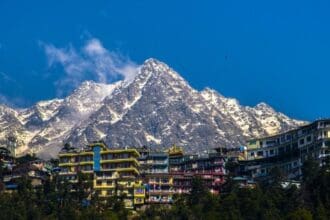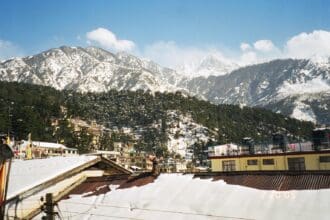The Masroor Rock Cut Temple, located approximately 40 kilometers from Dharamshala in the Kangra district of Himachal Pradesh, is a breathtaking testament to ancient Indian craftsmanship and spirituality. Set amidst the picturesque backdrop of the Dhauladhar ranges, this historic temple complex is a blend of architectural brilliance, religious devotion, and natural beauty.
Believed to have been constructed in the 8th century, the temple is renowned for its monolithic rock-cut design. Though slightly lesser-known compared to other historical sites, the Masroor Rock Cut Temple is often compared to the Ellora and Ajanta caves in Maharashtra for its similar artistic grandeur. The temple is also a significant pilgrimage destination for devotees of Lord Shiva and an architectural gem for history enthusiasts.
A Glimpse Into the History
The origins of the Masroor Rock Cut Temple remain somewhat shrouded in mystery, but historians and archaeologists attribute its construction to the reign of the Gupta Empire, a period considered the golden age of Indian culture and arts. The temple was believed to be a flourishing spiritual hub during ancient times, although it lost prominence over centuries due to natural calamities and changing political landscapes.
The temple also has a unique mythological significance. It is said to have been built by the Pandavas during their period of exile as mentioned in the Mahabharata. Legends suggest that the temple was never completed, which adds an air of intrigue to its history.
Architectural Marvel
The Masroor Rock Cut Temple complex consists of 15 rock-hewn temples carved out of a single monolithic rock. This kind of construction is exceedingly rare and demonstrates the incredible skill of ancient Indian artisans. The temple follows a North Indian Nagara style of architecture, characterized by pyramid-like spires (shikharas) that rise majestically into the sky.
Key Architectural Features:
- Main Shrine: The central temple is dedicated to Lord Shiva, with his sacred image enshrined in the sanctum sanctorum. The main temple also houses intricately carved idols of Lord Vishnu and Goddess Saraswati, signifying its importance in Hindu worship.
- Sculptural Art: The walls and pillars of the temple are adorned with detailed carvings and sculptures depicting various scenes from Hindu mythology. The carvings showcase deities, celestial beings, and sacred symbols, each intricately detailed.
- Shikharas (Spire): The towering shikharas are beautifully carved and form a significant part of the temple’s skyline. Despite the damage caused by earthquakes over centuries, the remnants of the shikharas still showcase the grandeur of their original design.
- Sacred Pool: A small rectangular water tank lies in front of the temple complex. The still waters of this tank reflect the temple structure, creating a mesmerizing view, especially during sunrise and sunset.
Spiritual Significance
The temple is primarily dedicated to Lord Shiva, the destroyer and transformer in the Hindu trinity of gods. However, it also features depictions of Vishnu and Goddess Saraswati, making it a multi-deity temple that holds immense religious importance for devotees.
Pilgrims flock to the temple to seek blessings and experience the peaceful, spiritual ambiance. The chants and prayers echoing through the ancient rock walls evoke a sense of tranquility and connection to divinity.
Exploring the Surroundings
The area surrounding the Masroor Rock Cut Temple is equally captivating. Surrounded by lush greenery and the dramatic backdrop of the snow-capped Dhauladhar Range, it offers visitors a peaceful escape from the hustle and bustle of city life.
- Nature Walks: The serene environment around the temple is ideal for leisurely walks, where you can enjoy the natural beauty of the Kangra Valley.
- Hiking and Trekking: Adventure enthusiasts can explore nearby trails that offer spectacular views of the landscape.
- Nearby Attractions: The Kangra Fort, Baijnath Temple, and the scenic town of Dharamshala are all within a reasonable distance, making it easy to combine multiple destinations into your trip.
How to Reach Masroor Rock Cut Temple
Reaching the Masroor Rock Cut Temple is relatively easy and offers a scenic journey:
- By Air: The nearest airport is Gaggal Airport (Dharamshala Airport), about 45 km from the temple.
- By Train: The closest railway station is Pathankot Railway Station, approximately 100 km away. From Pathankot, you can hire a taxi or board a bus to the temple.
- By Road: Regular buses and taxis are available from Dharamshala, Kangra, and Pathankot. The temple is well-connected by a network of state highways.
Once you arrive at the site, a short walk takes you to the temple complex, offering an opportunity to soak in the surrounding natural beauty.
Best Time to Visit
The best time to visit the Masroor Rock Cut Temple is during the summer months (March to June) when the weather is mild and pleasant, making outdoor exploration enjoyable. The post-monsoon season (October to November) is also ideal, as the landscape is lush and vibrant.
Avoid visiting during the monsoon (July to September) as the area can be prone to landslides and the paths may become slippery. Winters (December to February) can be chilly, but the snow-covered surroundings add a magical touch for those who don’t mind the cold.
Things to Remember
- Wear comfortable shoes as exploring the temple requires walking on uneven rocky paths.
- Respect the sanctity of the site by dressing modestly and refraining from loud behavior.
- Carry water and light snacks, as there are limited facilities near the temple.
- Photography is allowed but avoid touching or climbing on the carvings to preserve the monument.
Conclusion
The Masroor Rock Cut Temple is not just a religious site but a profound example of India’s rich architectural and cultural heritage. Visiting this temple offers a unique blend of history, spirituality, and natural beauty, making it a must-visit destination in Himachal Pradesh. Whether you’re a devotee, a history buff, or an adventurer, the Masroor Rock Cut Temple promises an unforgettable experience that will leave you in awe of its timeless grandeur.
FAQs about Masroor Rock Cut Temple, Dharamshala
- What is the Masroor Rock Cut Temple famous for?
The Masroor Rock Cut Temple is famous for its monolithic rock-cut architecture, intricate carvings, and spiritual significance as a temple dedicated to Lord Shiva. It is often compared to the Ellora and Ajanta caves for its artistic brilliance. - When was the Masroor Rock Cut Temple built?
The temple is believed to have been constructed in the 8th century during the Gupta period, which is considered the golden age of Indian art and culture. - What deities are worshipped in the Masroor Rock Cut Temple?
The temple is primarily dedicated to Lord Shiva, but it also features idols of Lord Vishnu and Goddess Saraswati, making it a multi-deity temple. - What is the mythological significance of the temple?
According to local legends, the Masroor Rock Cut Temple was built by the Pandavas during their exile as described in the Mahabharata. However, the construction was left incomplete. - How can I reach the Masroor Rock Cut Temple?
- By Air: The nearest airport is Gaggal Airport, about 45 km from the temple.
- By Train: The closest railway station is Pathankot, around 100 km away.
- By Road: The temple is well-connected by road and is approximately 40 km from Dharamshala.
- What is the best time to visit the Masroor Rock Cut Temple?
The best time to visit is during the summer months (March to June) and the post-monsoon season (October to November). Avoid visiting during the monsoon season as the area can be prone to landslides. - Are there any facilities available near the temple?
Facilities near the temple are limited. It is advisable to carry water, snacks, and other essentials. Some small shops may be available in the nearby village. - Is photography allowed at the Masroor Rock Cut Temple?
Yes, photography is allowed, and the temple’s architecture and scenic surroundings make it an excellent spot for capturing memorable pictures. - Can I trek or hike around the temple?
Yes, the area around the temple is ideal for light trekking and hiking, offering scenic views of the Dhauladhar Range and the surrounding landscape. - Is there an entry fee for the Masroor Rock Cut Temple?
Entry to the temple is usually free, but it’s recommended to confirm with local authorities as policies may change. - What other attractions are near the Masroor Rock Cut Temple?
Nearby attractions include the Kangra Fort, Baijnath Temple, McLeod Ganj, and the scenic landscapes of Dharamshala and Kangra Valley. - Is the temple suitable for elderly visitors?
While elderly visitors can enjoy the serene atmosphere of the temple, walking on uneven and rocky paths may be challenging for some. It is advisable to provide assistance if needed. - What is the significance of the water tank in front of the temple?
The water tank in front of the temple not only serves a ritual purpose but also enhances the beauty of the temple. The reflection of the temple in the tank creates a stunning visual effect, especially during sunrise and sunset. - Why is the temple called incomplete?
Some historians believe that the temple construction was left incomplete due to either natural disasters, invasions, or insufficient resources at the time. This adds to the mystery and intrigue of the site. - What makes the Masroor Rock Cut Temple unique?
Its unique feature lies in being carved out of a single monolithic rock, showcasing exceptional craftsmanship and standing as one of the few such structures in North India.








